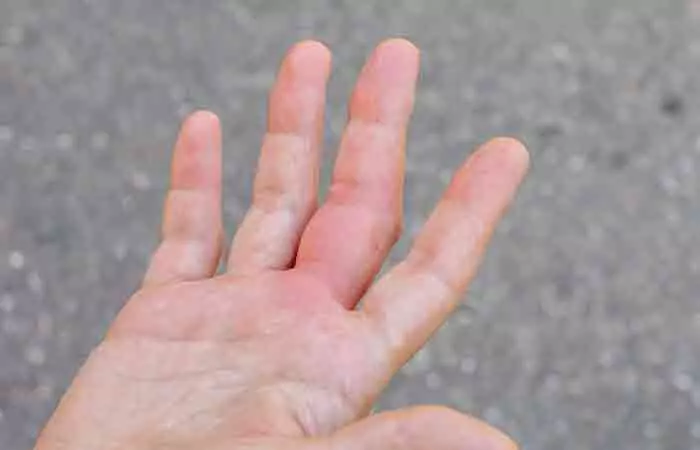There are a few types of arthritis that can affect the hands and fingers, like:
Osteoarthritis
Osteoarthritis (or degenerative arthritis) affects the wrist, the joint located at the base of the thumb, and the middle and top joints in the fingers. With osteoarthritis, you experience wear and tear of the cartilage which eventually leads the bones to rub against each other and get damaged. This progressive wearing down of the cartilage and bones may cause stiffness, deformities, and pain (2).
Rheumatoid Arthritis
Rheumatoid arthritis is an auto-immune disease in which the body’s natural immune system begins to attack its own healthy tissues, leading to inflammation in the lining of the joints. This causes a breakdown in the cartilage and eventually leads to the bones getting eroded. This chronic condition affects the small joints in the wrists, hands, and fingers symmetrically (the same joints in both hands get affected) (3).
Psoriatic Arthritis
Psoriatic arthritis is similar to rheumatoid arthritis and causes swelling of fingers. It also affects the skin and is commonly associated with morning stiffness and joint ache (4).
Gout
Gout is characterized by the formation of crystals within the joints due to accumulation of excess uric acid in the body. This condition generally affects the big toe, but it may also affect the finger joints and cause stiffness of fingers (5).
Post-Traumatic Arthritis
Post-traumatic arthritis is a condition that develops in a joint as a result of previous machine- and sports-related injuries, such as fractures, dislocations, and severe sprains. When the damaged structure repairs after injury, it may lead to stiffness or scarring. Over time, this can progress to arthritis, causing further joint degeneration. Fingers are the most affected part of a hand injury, occurring in up to 38.4% of cases (6).
Basal Thumb Arthritis
Basal thumb arthritis affects the joint at the base of your thumb. It happens when the protective cartilage wears down. This can make simple tasks such as gripping and pinching difficult as you feel stinging pain at the base of your thumb. One study states that it increases with age and mostly affects postmenopausal women (7). According to a CDC report, 58.5 million U.S. adults (23.7%) above 18 were estimated to have arthritis in the year 2016-18. Arthritis prevalence among adults aged 65 and above was 50.4%, adults unable to work or disabled was 52.3%, and adults with fair/poor self-rated health were 51.2%. You may experience the symptoms associated with arthritis in the base of your thumb, your knuckles, and the middle and top joints of your fingers. Let’s look at some of the symptoms that can help you identify finger arthritis.
Common Symptoms Of Finger Arthritis
Depending on the type of arthritis, you may experience one or more of these symptoms. The following are commonly associated symptoms with arthritis in fingers:
Pain in the joints Swelling in fingers or the joints Stiffness Loss of mobility Lumps or nodules around finger knuckles Crooked fingers that bend away from the thumb
All these are indicative of the underlying cause for the achy and stiff fingers. Let’s see what that is in the next section.
What Causes Finger Arthritis?
Arthritis in fingers develops when the cartilage that cushions the bones located at finger joints gets damaged. The joints are where two bones meet, and due to the damage to the cartilage, the smooth movement between the bones at those points gets affected. While there is not one single cause that is responsible for the development of arthritis, you are more at risk of getting it if you are (8):
Above 35 years old A woman Overweight Genetically prone Carrying any previous injury to your hand, wrist, or fingers
Arthritis in fingers can creep up on anyone, so it is best to know how to get rid of it as quickly as possible. Head on to the next section to find out how.
How To Get Rid Of Arthritis In Fingers
1. Exercise Your Hands And Fingers
You can strengthen the muscles that support the joints of your hands with a few simple exercises. The increased blood flow and the influx of nutrients can help your cartilage stay healthy and prevent further breakdown. Additionally, the stronger the muscles, the more weight they can carry. This further protects the damaged bones and cartilage (9). The following hand exercises may help you with arthritis pain in your fingers:
Make a gentle fist by slowly bending your four fingers into a fist, with your thumb remaining outwards. Gently squeeze and straighten your fingers. Bend each of the four fingers one by one. To do that, first, hold out your hand with the palm facing upwards. Next, take one finger and slowly move it to the center of your palm. Hold it there as you bend the remaining three fingers to touch the center of the palm. Release and straighten your hand. Gently and slowly bend your thumb to touch the palm. It is okay if you are unable to touch it. Just go as far as you can, hold for a few seconds and repeat. Try to form a C-shape or an O-shape with your fingers. To do that, move your fingers to grab an imaginary little ball. Go as close to the shapes as possible, straighten your fingers and start again. Make a loose fist with your fingers, with the little finger (pinky) resting on a flat surface. Then raise your thumb upwards in a thumbs-up sign. Bring it down and repeat. Lay your hand palm downwards on a flat surface. Then, lift and put down each finger one after the other. Do this for both hands. Squeeze a rubber ball gently and release. Repeat five times for each hand. Hold out your hand so that your palm is facing away from your face. Try to spread the fingers as wide as you can. Relax and return to the original position. Repeat thrice.
2. Use Ice And Heat Treatment
Both heat and cold can help bring relief from joint stiffness and arthritis fingers. While heat therapy may relieve stiffness, cold therapy can numb the hands and reduce joint pain and swelling (10), (11). Use cold therapy for not more than 20 minutes at a time and remove the ice pack as soon as your skin feels numb. A lot of people alternate between hot and cold treatment and you can do the same depending on what brings you the most relief. For heat therapy:
Take a warm shower. Soak your hands in a bowl of warm water. Use a heating pad or apply a warm compress on your fingers. Use a paraffin wax wrap. To do this, warm the wax and cover the fingers or your entire hand with the wax. Take care not to pour wax while it is extremely hot.
For cold therapy:
Wrap a thin towel around a bag of frozen vegetables and apply it to your achy fingers. Freeze a towel and wrap it around your fingers. Massage your fingers with a frozen bottle of water wrapped in a thin towel. Make an ice pack at home using a sock filled with uncooked rice grains. Keep it in the freezer and use it as and when required.
Note: Sometimes, a jammed finger can be mistaken for finger arthritis. However, a jammed finger does allow some range of motion while arthritis can make it extremely hard to move your fingers. Cold therapy is also a soothing natural treatment for jammed fingers that numbs the pain and alleviates swelling.
3. Take Supplements
Inflammation is often responsible for the pain and discomfort in finger arthritis. Research shows that EPA and DHA, which are omega-3 polyunsaturated fatty acids may help with reducing inflammation (12). According to a study, ginger supplements may also be helpful in reducing symptoms of rheumatoid arthritis (13). Talk to your doctor about the dosage for any supplements that you may want to take.
4. Massage Your Fingers
Research shows that massage therapy for hand arthritis may help in mobility and reduce pain (14). Use any unrefined oil like unprocessed coconut oil and work on the muscles in your hands and the finger joints. Use the thumb, index, and middle fingers of your massaging hand and gently rub your joints and muscles in a rotating motion. While self-massaging is something you can do at home, visit a massage therapist for proper hand therapy and to get the technique perfected. While home remedies may help alleviate some of the pain associated with arthritis, it is important to know when to visit your doctor. Dominic Kent, an author, shared his experience with rheumatoid arthritis and how he found relief with some simple tips. He stated that, “There are just a few additional steps I must take, in order to try to combat the numbing pain in my fingers. Wash my hands under the hot tap for a few minutes. Moisturise hands (the process of rubbing fingers together is more important here than actually moisturising them) (i).”
When To See A Doctor
Talk to your doctor when you have symptoms of arthritis to get a proper diagnosis as that can determine the best treatment options for you. It is best to get arthritis checked and treated early as it may lead to complete loss of movement in your hands and fingers if allowed to progress unchecked. Arthritis may not be curable, but there may be a few things you can do to prevent it or at least lower your risk of getting it.
How To Prevent Arthritis In Fingers
As you may be predisposed to arthritis in fingers, following these can reduce your chances of developing the condition:
Regular hand and finger exercises Taking good care of hands and fingers after they sustain any kind of injury Quitting cigarettes (15)
Arthritis in fingers may be a result of osteoarthritis, rheumatoid arthritis, gout, or psoriatic arthritis. Some people are more prone to arthritis than others as lifestyle, previous injuries, and genetics play a role in the development of the condition. While arthritis cannot be reversed completely, early treatment may slow down its progress. You can manage the symptoms of arthritis with regular exercise, supplementation, and hot or cold massage. It is important that you work with your healthcare professional throughout to get the most out of your arthritis treatment and management options. What vitamin helps arthritis in fingers? Vitamins C, D, E, and K may help alleviate pain, joint inflammation, and oxidative stress in people with arthritis (17), (18), (19), (20). Therefore do include these vitamins in your arthritis diet. Why is arthritis in fingers pain worse at night? While the exact cause behind this is unknown, it may possibly be linked to changes in the circadian rhythm (21). Is apple cider vinegar good for arthritis? There is currently no evidence that suggests that apple cider vinegar may help manage arthritis. Is yogurt good for arthritis? Yes, yogurt has anti-inflammatory and antioxidant properties that may help manage arthritis (22). How should I sleep with arthritis in my hands? You should ideally sleep straight on your back or lie on the unaffected side of your body. Avoid sleeping on your stomach Learn all about arthritis in the fingers from this video! Get the facts on symptoms, causes, treatments, and more by watching the video below.











